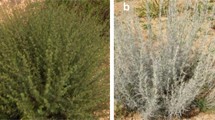Abstract
Pistacia terebinthus L. and Pistacia lentiscus L. leaves are widely used in Algerian folk medicine. For the first time, P. terebinthus and P. lentiscus leaves, were subjected to determine their essential and toxic elements using instrumental neutron activation analysis (INAA). P. terebinthus and P. lentiscus leaves were collected from two different locations in Algeria and exposed to INAA analysis. The results show that the mass fractions of the sixteen trace elements studied are within the tolerance limits imposed by the World Health Organization. Hence these results could therefore be used to provide scientific basis for an optimum usage and enriches the database of medicinal herbs.


Similar content being viewed by others
References
Belhachat D, Mekimene L, Belhachat M et al (2018) Application of response surface methodology to optimize the extraction of essential oil from ripe berries of Pistacia lentiscus using ultrasonic pretreatment. J Appl Res Med Aromat Plants 9:132–140. https://doi.org/10.1016/j.jarmap.2018.04.003
Ben Ahmed Z, Yousfi M, Viaene J et al (2016) Determination of optimal extraction conditions for phenolic compounds from Pistacia atlantica leaves using the response surface methodology. Anal Methods 8:6107–6114. https://doi.org/10.1039/C6AY01739H
Bozorgi M, Memariani Z, Mobli M et al (2013) A review of their traditional uses, phytochemistry, and pharmacology. Sci World J 2013:33. https://doi.org/10.1155/2013/219815
Durmaz G, Gökmen V (2011) Changes in oxidative stability, antioxidant capacity and phytochemical composition of Pistacia terebinthus oil with roasting. Food Chem 128:410–414. https://doi.org/10.1016/j.foodchem.2011.03.044
Longo L, Scardino A, Vasapollo G (2007) Identification and quantification of anthocyanins in the berries of Pistacia lentiscus L., Phillyrea latifolia L. and Rubia peregrina L. Innov Food Sci Emerg Technol 8:360–364. https://doi.org/10.1016/j.ifset.2007.03.010
Alsabbagh A, Khalayleh L, Dbissi M, Landsberger S (2017) An assessment study in the determination of chemical elements in sediments and fish in the Zarka River and King Talal Dam, Jordan. J Radioanal Nucl Chem 314:141–147. https://doi.org/10.1007/s10967-017-5355-2
Orvini E, Speziali M, Herborg C, Salvini A (2005) Trace element characterization by INAA of three sediments to be certified as standard reference materials. Microchem J 79:239–242
El-Sweify FH, El-Amir MA, Mostafa M et al (2016) Simultaneous multi-element determination in different seed samples of Dodonaea viscosa hopseed using instrumental neutron activation analysis. Radiochim Acta 104:211–220
Begaa S, Messaoudi M (2019) Toxicological aspect of some selected medicinal plant samples collected from Djelfa, Algeria Region. Biol Trace Elem Res 187:301–306
Benyoussef E-H, Charchari S, Nacer-Bey N et al (2005) The essential oil of Pistacia lentiscus L. from Algeria. J Essent Oil Res 17:642–644
Gourine N, Yousfi M, Bombarda I et al (2010) Antioxidant activities and chemical composition of essential oil of Pistacia atlantica from Algeria. Ind Crops Prod 31:203–208
Ben Ahmed Z, Yousfi M, Viaene J et al (2016) Antioxidant activities of Pistacia atlantica extracts modeled as a function of chromatographic fingerprints in order to identify antioxidant markers. Microchem J 128:208–217. https://doi.org/10.1016/j.microc.2016.04.023
Garg AN, Gajbhiye PT, Choudhury RP (2017) INAA of essential micronutrients in Terminalia arjuna bark powder: a versatile heart tonic. J Radioanal Nucl Chem 314:1539–1545. https://doi.org/10.1007/s10967-017-5564-8
Begaa S, Messaoudi M (2018) Thermal neutron activation analysis of some toxic and trace chemical element contents in Mentha pulegium L. Radiochim Acta. https://doi.org/10.1515/ract-2018-2942
Wu D, Landsberger S, Larson SM (1997) Determination of the elemental distribution in cigarette components and smoke by instrumental neutron activation analysis. J Radioanal Nucl Chem 217:77–82
No A, Committee AM (2016) z-Scores and other scores in chemical proficiency testing—their meanings, and some common misconceptions. Anal Methods 8:5553–5555
Rahman M, Islam MA, Khan RA (2018) Characterization of chemical elements in common spices of Bangladesh for dietary intake and possible health risk assessment by INAA and AAS techniques. J Radioanal Nucl Chem 318:1347–1357
Beto JA (2015) The role of calcium in human aging. Clin Nutr Res 4:1–8
Messaoudi M, Begaa S (2018) Application of INAA technique for analysis of essential trace and toxic elements in medicinal seeds of Carum carvi L. & Foeniculum vul-gare Mill. used in Algeria. J Appl Res Med Aromat Plants 9:39–45
Garg AN, Paul Choudhury R, Acharya R, Reddy AVR (2012) Determination of minor, trace and toxic elements in chewing tobacco products by instrumental neutron activation analysis and identification of glutamic acid. J Radioanal Nucl Chem 294:197–202. https://doi.org/10.1007/s10967-012-1845-4
Arzani A, Zeinali H, Razmjo K (2007) Iron and magnesium concentrations of mint accessions (Mentha spp.). Plant Physiol Biochem 45:323–329
Zaidi JH, Fatima I, Qureshi IH, Subhani MS (2004) Trace elements evaluation of some medicinal herbs by instrumental neutron activation analysis. Radiochim Acta 92:363–368
Mertz W (1993) Chromium in human nutrition: a review. J Nutr 123:626–633
Organization WHO (1996) Trace elements in human nutrition and health. WHO, Geneva
Abernathy CO, Thomas DJ, Calderon RL (2003) Health effects and risk assessment of arsenic. J Nutr 133:1536S–1538S
Mertz W (2012) Trace elements in human and animal nutrition. Elsevier, Amsterdam
Joint WHO/FAO (1999). Expert committee on food additives. Summary and conclusions. In: 53rd meeting, Rome
Acknowledgements
This work has been carried out and supported by Algerian Ministry of Higher Education and Scientific Research, the authors thank all the members of the Department of Neutron Activation Analysis (Es-Salam Nuclear Research Centre of Birine, Djelfa) for the technical assistance.
Author information
Authors and Affiliations
Corresponding author
Ethics declarations
Conflict of interest
The authors declare that they have no conflict of interest.
Additional information
Publisher's Note
Springer Nature remains neutral with regard to jurisdictional claims in published maps and institutional affiliations.
Rights and permissions
About this article
Cite this article
Hamlat, N., Benarfa, A., Beladel, B. et al. Assessment of the contents of essential and potentially toxic elements in Pistacia terebinthus L. and Pistacia lentiscus L. by INAA technique. J Radioanal Nucl Chem 322, 1127–1131 (2019). https://doi.org/10.1007/s10967-019-06815-z
Received:
Published:
Issue Date:
DOI: https://doi.org/10.1007/s10967-019-06815-z




